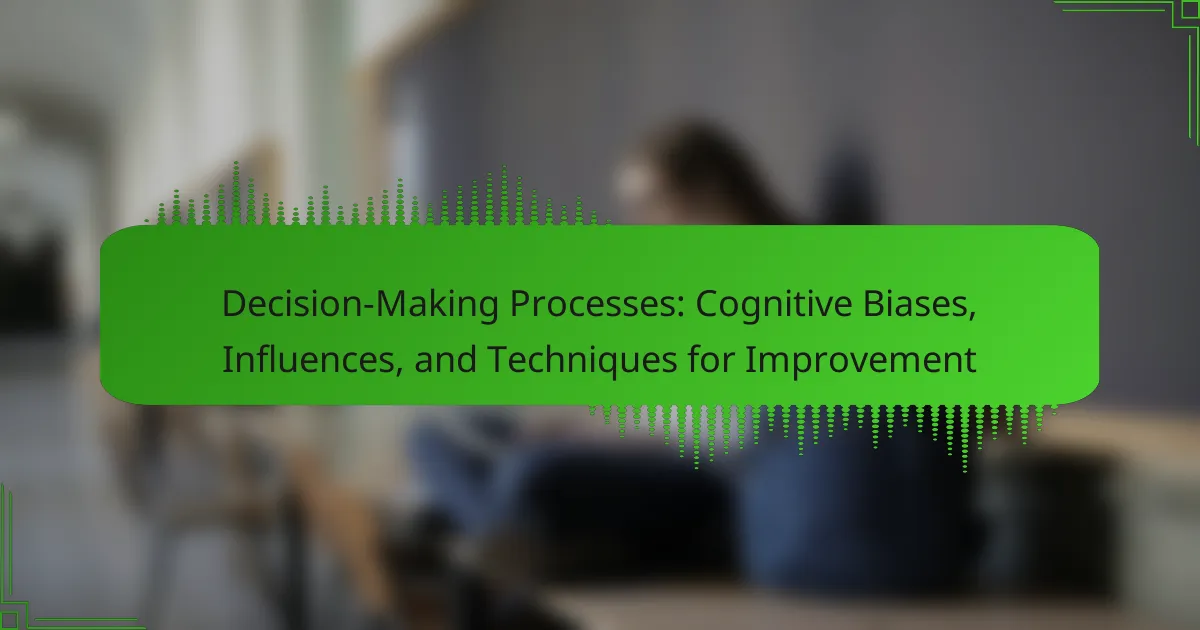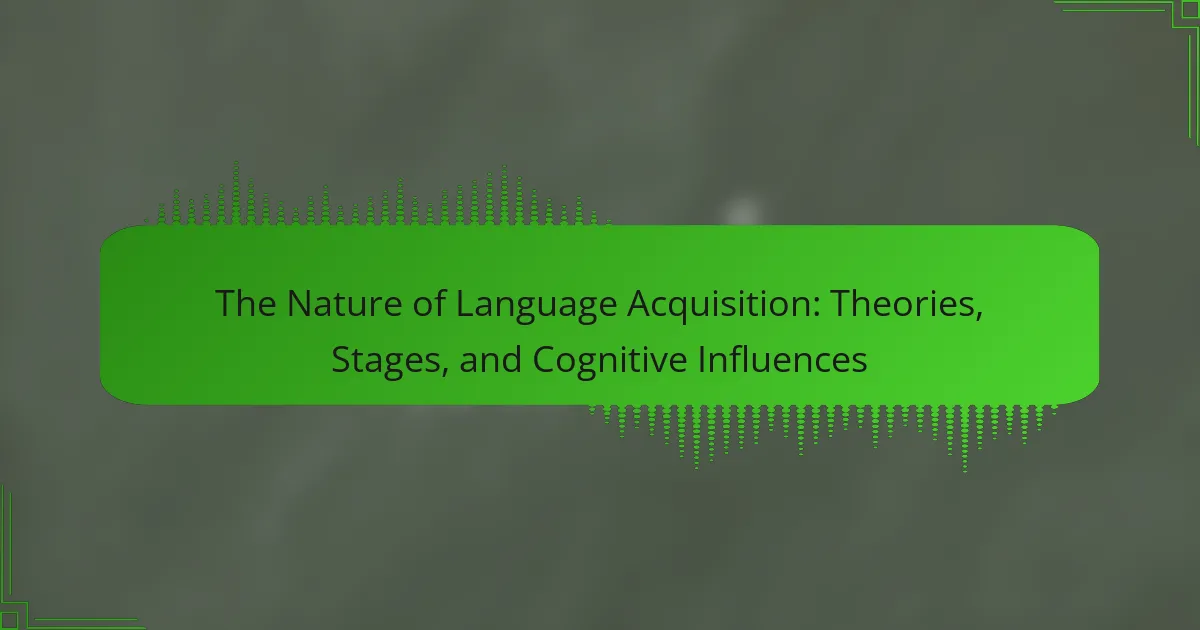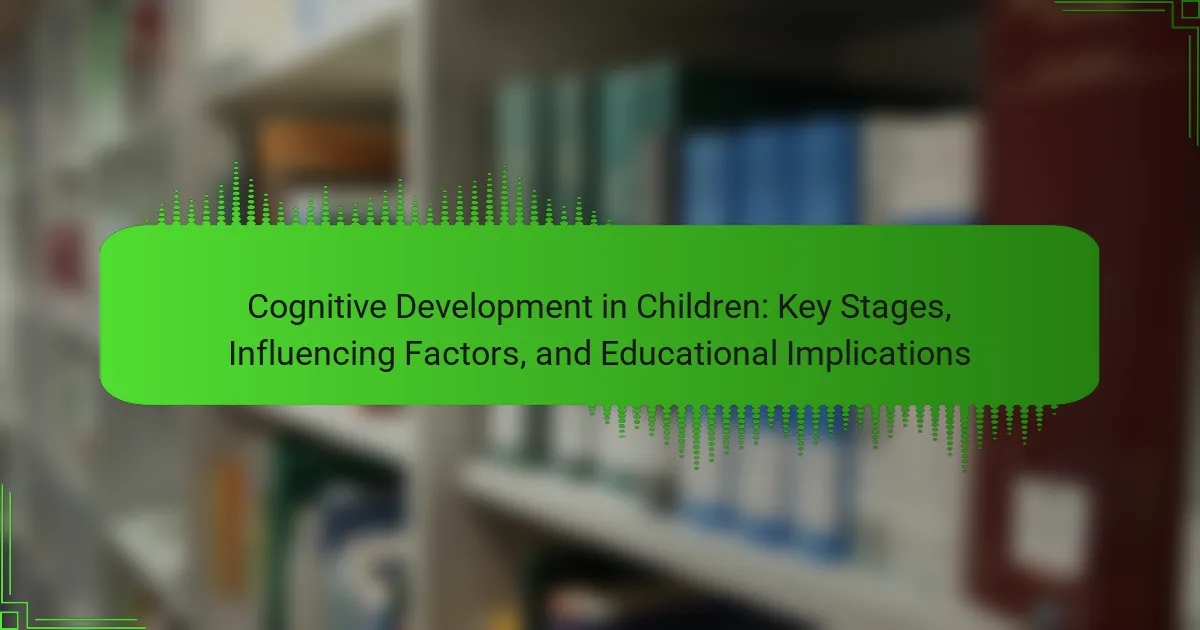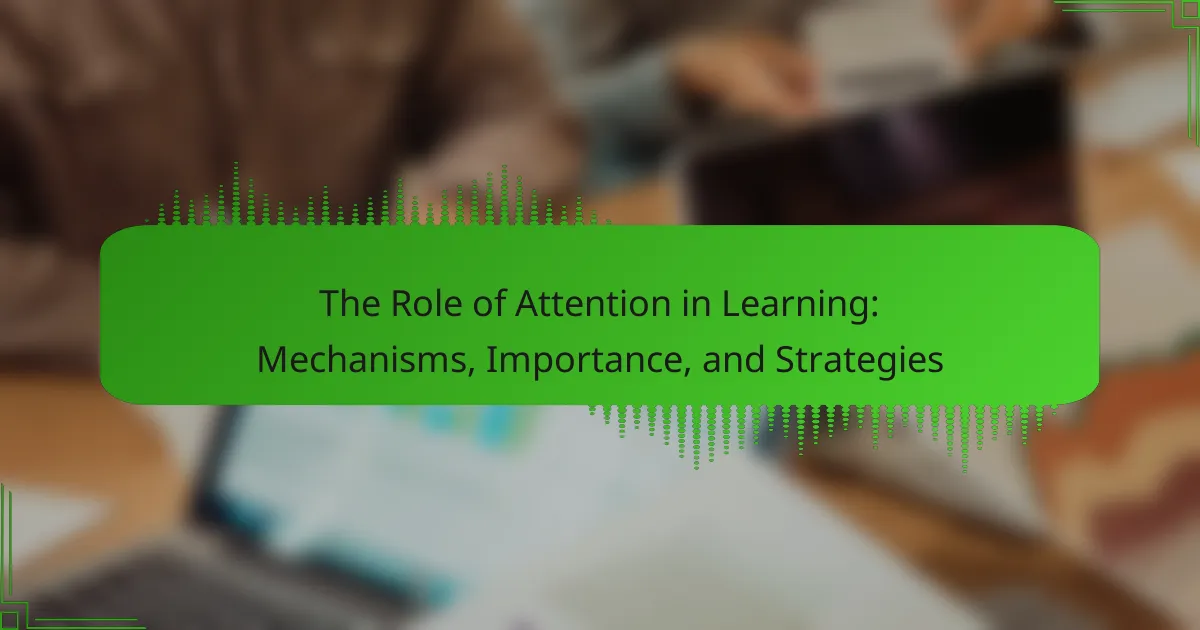Decision-making processes encompass the steps individuals or groups follow to select among various alternatives, involving the identification of a decision, information gathering, and option evaluation. These processes are significantly impacted by cognitive biases, emotions, and social influences, which can distort judgment and lead to suboptimal choices. Structured decision-making techniques, such as SWOT analysis and collaborative approaches, have been shown to enhance decision outcomes by promoting clarity and reducing biases. Understanding these factors and techniques is essential for improving decision-making effectiveness and achieving better results.
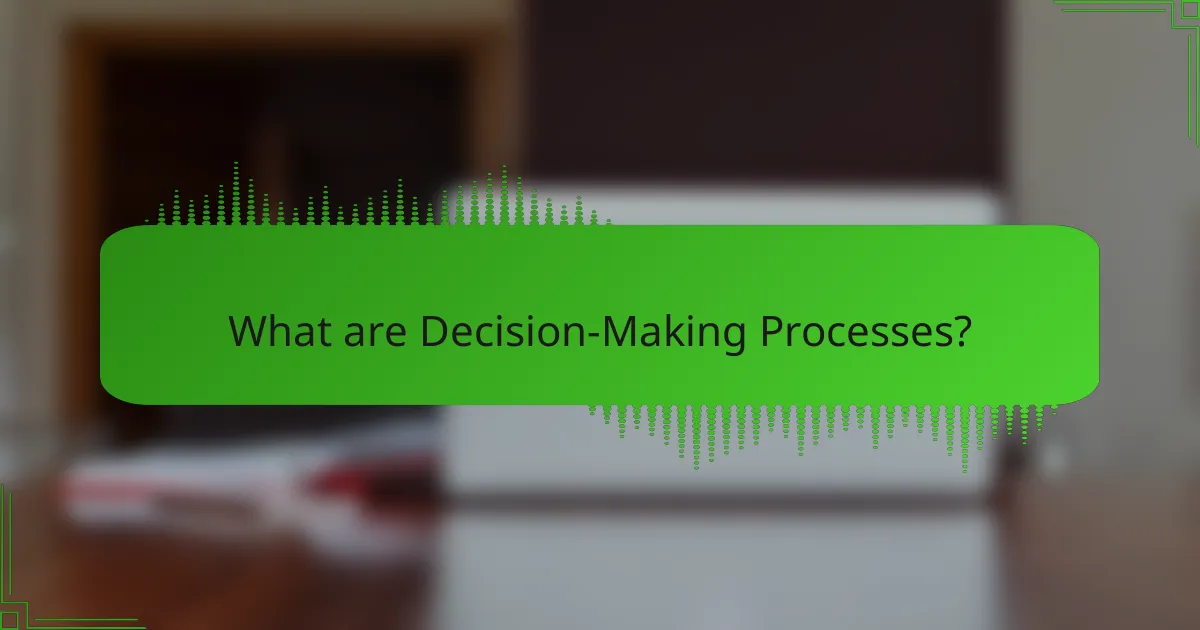
What are Decision-Making Processes?
Decision-making processes are the steps individuals or groups take to choose among alternatives. These processes typically involve identifying a decision, gathering relevant information, and weighing options. Decision-making can be influenced by cognitive biases, emotions, and social factors. Research shows that structured decision-making improves outcomes. For instance, a study by Simon (1977) highlights the importance of systematic approaches in decision-making. By following defined processes, individuals can reduce errors and enhance their choices.
How do Decision-Making Processes impact our daily lives?
Decision-making processes significantly influence our daily lives by shaping our choices and actions. These processes determine how we evaluate options and make judgments. For example, individuals often rely on heuristics, or mental shortcuts, to simplify complex decisions. This reliance can lead to cognitive biases, which may result in suboptimal choices. Research shows that biases like confirmation bias can skew our perceptions and reinforce existing beliefs. Furthermore, decision-making impacts various aspects of life, from financial choices to health-related behaviors. Studies indicate that effective decision-making can improve overall well-being and satisfaction. In essence, the way we make decisions directly affects our quality of life and the outcomes we experience.
What are the stages involved in Decision-Making Processes?
The stages involved in decision-making processes are problem identification, information gathering, evaluation of alternatives, choice selection, implementation, and review. Problem identification is recognizing the need for a decision. Information gathering involves collecting relevant data and insights. Evaluation of alternatives requires assessing the options based on defined criteria. Choice selection is the act of deciding on the best alternative. Implementation is putting the chosen option into action. Review entails assessing the outcome of the decision and making adjustments if necessary. These stages create a structured approach to effective decision-making.
How do different contexts influence Decision-Making Processes?
Different contexts significantly influence decision-making processes by shaping the information available and the perceived consequences of choices. Contexts can include social environments, cultural backgrounds, and situational factors. For instance, decisions made in a collaborative setting may prioritize group consensus over individual preferences. Research shows that individuals are more likely to take risks in a group context due to shared responsibility. Moreover, cultural contexts can affect the values and norms that guide decision-making. A study by Hofstede (1980) highlights how individualistic cultures prioritize personal achievement, while collectivist cultures emphasize group harmony. Situational factors, such as time pressure or resource availability, can also impact the urgency and quality of decisions made. In summary, the specific context in which a decision is made can alter the decision-maker’s approach, priorities, and outcomes.
Why is understanding Decision-Making Processes important?
Understanding decision-making processes is important because it enhances the quality of choices made. Effective decisions lead to better outcomes in personal and professional contexts. Knowledge of these processes helps identify cognitive biases that can distort judgment. For instance, a study by Tversky and Kahneman in 1974 demonstrated how biases affect decision-making under uncertainty. Additionally, understanding these processes fosters critical thinking and problem-solving skills. Improved decision-making can increase productivity and satisfaction in various areas of life. Organizations benefit from informed decisions, leading to strategic advantages. Ultimately, grasping decision-making processes is crucial for achieving desired results and minimizing errors.
What role do Decision-Making Processes play in personal development?
Decision-making processes are crucial in personal development. They guide individuals in evaluating options and making choices that align with their goals. Effective decision-making enhances self-awareness and responsibility. It promotes critical thinking and problem-solving skills. Research shows that individuals who use structured decision-making approaches report higher satisfaction in their life choices. By analyzing the outcomes of decisions, individuals can learn and adapt. This iterative process fosters growth and resilience. Ultimately, decision-making shapes personal identity and future aspirations.
How can Decision-Making Processes affect organizational success?
Decision-making processes significantly impact organizational success. Effective decision-making leads to improved strategic alignment and resource allocation. Organizations that utilize data-driven decision-making often achieve higher performance. A study by McKinsey found that companies with strong decision-making processes are 2.5 times more likely to outperform their peers. Poor decision-making can result in wasted resources and missed opportunities. Additionally, cognitive biases can distort judgment, leading to suboptimal choices. By implementing structured decision-making techniques, organizations can mitigate these biases. This enhances collaboration and fosters a culture of accountability. Ultimately, sound decision-making processes are crucial for achieving long-term organizational goals.
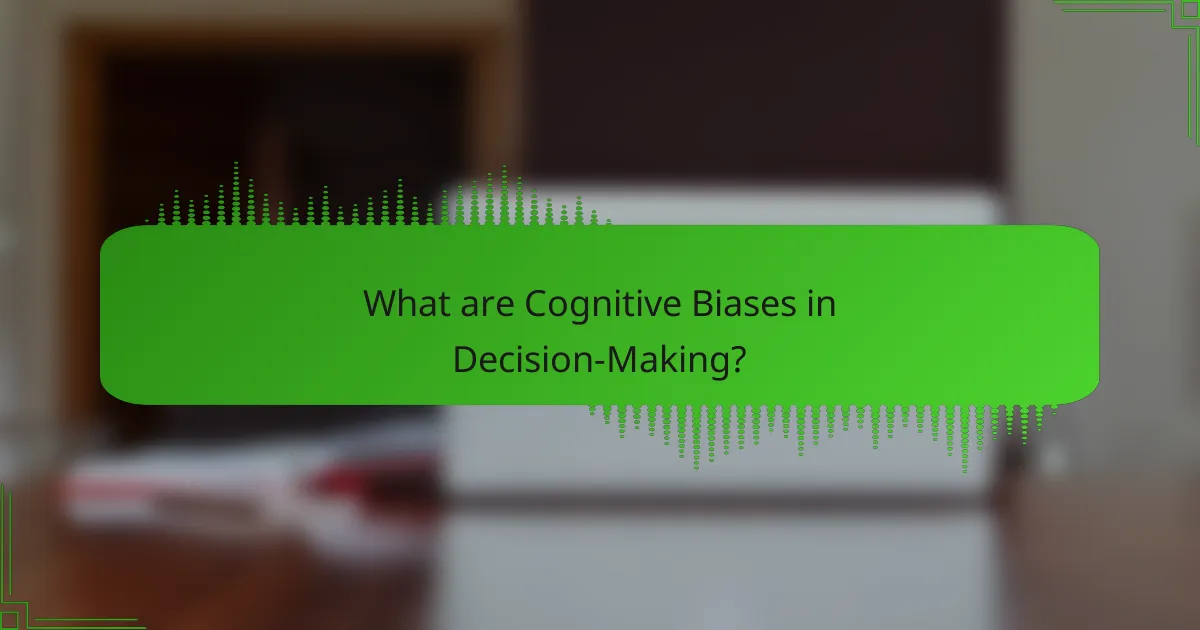
What are Cognitive Biases in Decision-Making?
Cognitive biases in decision-making are systematic patterns of deviation from norm or rationality in judgment. These biases affect how individuals interpret information and make choices. Common cognitive biases include confirmation bias, where people favor information that confirms their preexisting beliefs. Anchoring bias occurs when individuals rely too heavily on the first piece of information encountered. Research shows that cognitive biases can lead to poor decision outcomes, as they distort perception and reasoning. Studies indicate that awareness of these biases can improve decision-making processes. Understanding cognitive biases is crucial for making more informed and rational choices.
How do Cognitive Biases influence our decisions?
Cognitive biases significantly influence our decisions by altering our perception and judgment. These biases can lead to systematic deviations from rationality. For example, confirmation bias causes individuals to favor information that confirms their pre-existing beliefs. Anchoring bias leads people to rely heavily on the first piece of information encountered when making decisions.
Research shows that cognitive biases can affect choices in various contexts, such as finance and health. A study by Tversky and Kahneman highlighted how biases impact decision-making under uncertainty. Their work demonstrated that people often misjudge probabilities due to biases like overconfidence and availability heuristic.
These cognitive shortcuts can result in poor decision outcomes. Understanding these biases helps individuals recognize and mitigate their effects. By being aware of cognitive biases, one can strive for more rational and informed decision-making.
What are the most common Cognitive Biases encountered?
The most common cognitive biases encountered include confirmation bias, anchoring bias, and availability heuristic. Confirmation bias occurs when individuals favor information that confirms their preexisting beliefs. Anchoring bias refers to the tendency to rely heavily on the first piece of information encountered when making decisions. The availability heuristic is the mental shortcut that relies on immediate examples that come to mind. These biases affect decision-making processes significantly. According to research by Tversky and Kahneman, cognitive biases can lead to systematic deviations from rationality in judgment. Their findings highlight the pervasive nature of these biases in everyday decisions.
How do Cognitive Biases lead to poor decision-making?
Cognitive biases lead to poor decision-making by distorting perception and judgment. These biases cause individuals to rely on subjective experiences rather than objective analysis. For example, confirmation bias leads people to favor information that supports their existing beliefs. This can result in overlooking critical data that contradicts those beliefs. Anchoring bias causes reliance on initial information, skewing subsequent decisions. Availability heuristic makes recent or vivid events more influential than they should be. Research shows that cognitive biases can significantly impact choices in various fields, including finance and healthcare. A study by Tversky and Kahneman highlights how biases affect decision-making processes. Their work demonstrates that cognitive shortcuts often lead to errors in judgment.
What strategies can mitigate Cognitive Biases?
Cognitive biases can be mitigated through several strategies. One effective strategy is awareness training. Educating individuals about common cognitive biases helps them recognize these biases in their own thinking. Another strategy is the use of structured decision-making processes. Techniques like checklists or decision trees can guide individuals to consider multiple perspectives. Seeking feedback from others is also beneficial. Collaborating with diverse teams can reduce groupthink and enhance critical evaluation. Implementing a delay in decision-making can provide time for reflection. This allows individuals to reassess their initial judgments. Finally, using data-driven approaches can counteract emotional biases. Relying on objective information leads to more rational decisions. Studies show that these strategies significantly improve decision quality and reduce bias influence.
How can awareness of Cognitive Biases improve decision-making?
Awareness of cognitive biases can significantly improve decision-making. Cognitive biases are systematic patterns of deviation from norm or rationality in judgment. Recognizing these biases allows individuals to identify flawed reasoning in their thought processes. This awareness leads to more objective evaluations of information. For instance, understanding confirmation bias helps in seeking diverse perspectives. Research shows that informed decision-makers are more likely to achieve favorable outcomes. A study by Kahneman and Tversky highlights how awareness reduces errors in judgment. By mitigating biases, individuals can enhance their critical thinking skills. Ultimately, this leads to better choices and improved results in various contexts.
What techniques can be employed to counteract Cognitive Biases?
Cognitive biases can be counteracted using several techniques. One effective method is to increase awareness of biases. Training programs can educate individuals about common cognitive biases and their effects. Another technique is to implement structured decision-making processes. These processes can include checklists or decision trees to guide choices.
Encouraging diverse perspectives can also help reduce biases. Group discussions that incorporate multiple viewpoints can challenge individual biases. Additionally, using data-driven approaches can minimize subjective judgment. Analyzing empirical evidence can lead to more objective decisions.
Finally, practicing mindfulness can enhance critical thinking. Mindfulness techniques can improve focus and reduce impulsive reactions. These techniques collectively contribute to better decision-making by mitigating the impact of cognitive biases.
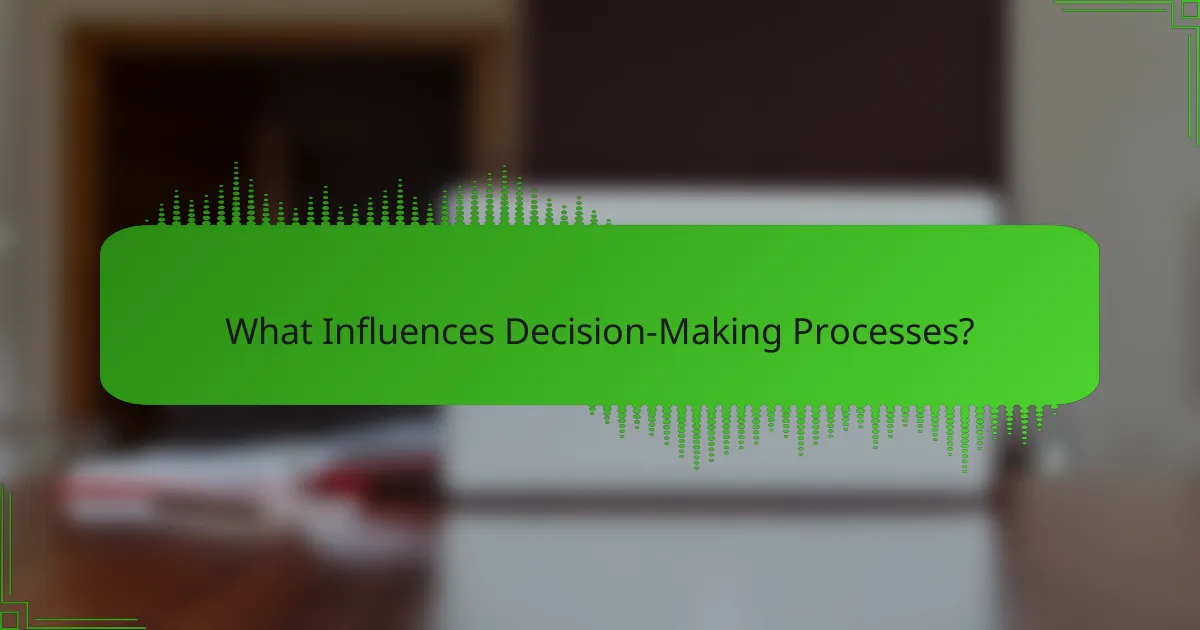
What Influences Decision-Making Processes?
Decision-making processes are influenced by various factors. Key influences include cognitive biases, emotions, social pressures, and available information. Cognitive biases, such as confirmation bias, can distort judgment. Emotions often affect choices, leading to impulsive decisions. Social pressures, including peer influence, can sway individual choices. The quality and quantity of information available also shape decisions. Research indicates that individuals often rely on heuristics, which can simplify complex decisions but may lead to errors. Understanding these influences can improve decision-making effectiveness.
How do social factors impact Decision-Making Processes?
Social factors significantly influence decision-making processes. These factors include group dynamics, cultural norms, and social pressures. Group dynamics can lead to conformity, where individuals align their choices with the majority. Cultural norms shape preferences and values, affecting decisions based on societal expectations. Social pressures can create urgency or fear of judgment, prompting quick choices without thorough analysis. Research shows that decisions made in group settings often differ from those made individually, as individuals may prioritize harmony over personal judgment. Studies indicate that approximately 75% of people conform to group opinions, highlighting the impact of social factors on decision-making.
What role does groupthink play in decision-making?
Groupthink negatively impacts decision-making by promoting conformity over critical analysis. It occurs when a group prioritizes harmony and consensus, leading to poor decisions. Members may suppress dissenting opinions to avoid conflict. This can result in a lack of creativity and innovation. Historical examples include the Bay of Pigs invasion, where groupthink led to disastrous outcomes. Research shows that groupthink can decrease overall group effectiveness. In contrast, encouraging diverse viewpoints can enhance decision quality.
How can peer pressure affect individual choices?
Peer pressure can significantly influence individual choices by creating a strong desire to conform to group norms. This social influence often leads individuals to make decisions they might not otherwise consider. For example, adolescents may engage in risky behaviors, such as substance use, to fit in with their peers. Research indicates that 70% of teens report feeling pressured to try drugs or alcohol by friends. Additionally, peer pressure can affect academic choices, leading students to prioritize social activities over studies. The pressure to maintain social acceptance can override personal values and beliefs, resulting in choices that conflict with an individual’s true preferences.
What environmental factors influence Decision-Making Processes?
Environmental factors significantly influence decision-making processes. These factors include social dynamics, cultural context, and physical surroundings. Social dynamics, such as groupthink or peer pressure, can lead individuals to conform to collective decisions. Cultural context shapes values and beliefs, affecting choices made in various situations. Physical surroundings, including noise levels and spatial layout, can impact cognitive function and emotional state. Research shows that decision-making is often context-dependent, with environmental cues guiding choices. For instance, studies indicate that ambient noise can enhance creativity but hinder focus, thus affecting outcomes.
How does time pressure affect decision outcomes?
Time pressure significantly impacts decision outcomes by leading to quicker, often less accurate choices. Under time constraints, individuals tend to rely on heuristics or mental shortcuts. This reliance can result in cognitive biases, such as overconfidence or anchoring. Research indicates that time pressure can decrease the quality of decisions made. A study by Dijksterhuis et al. (2006) found that people under time pressure made more impulsive choices. Additionally, time pressure can increase stress, further impairing cognitive functions. Ultimately, decisions made under time pressure may prioritize speed over thoroughness and accuracy.
What impact does information overload have on decision-making?
Information overload negatively impacts decision-making. It leads to confusion and indecision. Individuals may struggle to process excessive data. This can result in poor choices or avoidance of decisions altogether. Studies indicate that too much information can overwhelm cognitive capacity. Research shows that decision quality declines when faced with excessive options. For instance, a 2000 study by Iyengar and Lepper found that more choices can decrease satisfaction and increase regret. Thus, information overload can hinder effective decision-making.
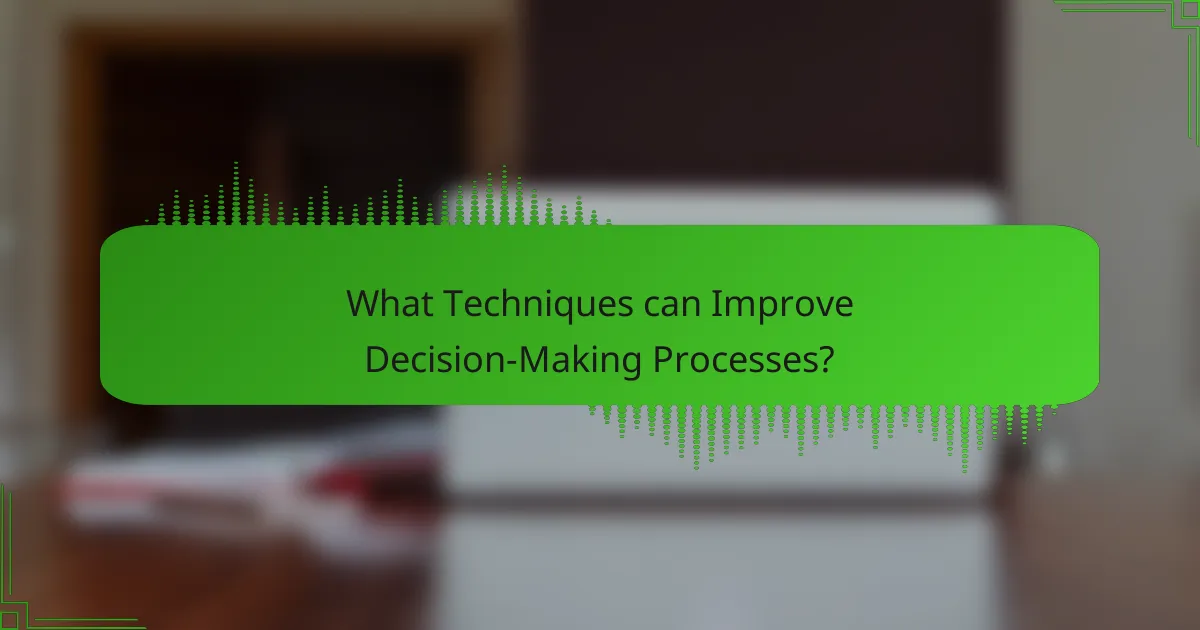
What Techniques can Improve Decision-Making Processes?
Techniques that can improve decision-making processes include the use of structured frameworks, data analysis, and collaborative approaches. Structured frameworks, like SWOT analysis, help clarify strengths, weaknesses, opportunities, and threats. Data analysis provides insights from quantitative information, guiding more informed choices. Collaborative approaches involve team discussions, which can lead to diverse perspectives and reduce individual biases. Research shows that teams making decisions together often outperform individuals, as highlighted in “The Wisdom of Crowds” by James Surowiecki. These techniques collectively enhance clarity, objectivity, and effectiveness in decision-making.
How can critical thinking enhance decision-making?
Critical thinking enhances decision-making by enabling individuals to analyze information systematically. It encourages questioning assumptions and evaluating evidence critically. This process reduces the influence of cognitive biases, leading to more rational choices. Research indicates that critical thinking skills improve problem-solving abilities. For instance, a study by Facione (2015) shows that individuals trained in critical thinking make better decisions in complex scenarios. By applying critical thinking, decision-makers can identify potential outcomes more effectively. This results in more informed and objective conclusions. Ultimately, critical thinking fosters better decision-making outcomes in various contexts.
What are the steps to develop critical thinking skills?
To develop critical thinking skills, follow these steps: First, cultivate curiosity by asking questions about the world around you. Next, gather relevant information from credible sources. Analyze the information critically, identifying biases and assumptions. Then, evaluate arguments and evidence logically. Consider alternative viewpoints to broaden your perspective. Practice problem-solving by applying critical thinking to real-life situations. Finally, reflect on your thought processes and outcomes to improve future decision-making. Research indicates that engaging in these practices enhances cognitive abilities and decision-making quality.
How does critical thinking help in evaluating options?
Critical thinking enhances the evaluation of options by promoting objective analysis. It allows individuals to assess information critically and discern relevant facts. This process involves questioning assumptions and identifying biases. Critical thinking encourages the exploration of alternative perspectives. It aids in weighing the pros and cons of each option effectively. Research indicates that critical thinkers make more informed decisions. A study published in the “Journal of Educational Psychology” found that critical thinking skills correlate with better problem-solving outcomes. By applying critical thinking, individuals can navigate complex choices with greater clarity and confidence.
What role does emotional intelligence play in decision-making?
Emotional intelligence significantly influences decision-making. It allows individuals to recognize and understand their own emotions and those of others. This awareness aids in evaluating situations more accurately. High emotional intelligence leads to better interpersonal relationships. It enhances communication and collaboration, crucial in group decision-making. Research shows that emotionally intelligent leaders make more effective decisions. They consider the emotional impact of their choices. This approach fosters a positive work environment and improves team performance. Studies indicate that organizations with emotionally intelligent leaders experience higher employee satisfaction and retention.
How can emotional intelligence improve interpersonal decisions?
Emotional intelligence enhances interpersonal decisions by improving understanding and management of emotions. It allows individuals to recognize their own feelings and those of others. This recognition fosters empathy, leading to better communication. Improved communication reduces misunderstandings and conflicts. Additionally, emotional intelligence aids in conflict resolution by promoting collaborative problem-solving. Research by Goleman shows that high emotional intelligence correlates with effective leadership and teamwork. Teams with emotionally intelligent members demonstrate higher performance and satisfaction. Thus, emotional intelligence significantly contributes to more informed and effective interpersonal decision-making.
What strategies can enhance emotional intelligence for better decision-making?
Strategies that can enhance emotional intelligence for better decision-making include self-awareness, empathy, and active listening. Self-awareness allows individuals to recognize their emotions and how these affect their decisions. Empathy helps in understanding others’ perspectives, leading to more informed choices. Active listening facilitates better communication, ensuring that all viewpoints are considered.
Mindfulness practices can also improve emotional regulation. Research indicates that mindfulness increases emotional awareness and reduces impulsive reactions. Developing social skills is crucial for effective collaboration and conflict resolution. Training programs focused on emotional intelligence can provide structured learning experiences.
According to a study by Goleman, emotional intelligence accounts for 58% of performance in various job types. This demonstrates the importance of emotional intelligence in decision-making contexts.
What practical tips can enhance effective decision-making?
Define effective decision-making as the process of making choices that yield the best outcomes. Practical tips to enhance this process include gathering relevant information. This involves researching facts and data pertinent to the decision at hand. Another tip is to consider multiple perspectives. Engaging with diverse viewpoints can reveal blind spots and enrich understanding.
Additionally, setting clear criteria for evaluating options is crucial. This helps to objectively assess the pros and cons of each choice. Prioritizing options based on these criteria can streamline the decision-making process. It is also beneficial to limit the number of choices. Research indicates that too many options can lead to decision fatigue.
Taking breaks during the decision-making process can improve clarity and reduce stress. This allows for reflection and can lead to more thoughtful decisions. Lastly, seeking feedback from trusted peers can provide valuable insights. Their perspectives can help validate or challenge one’s thinking.
How can setting clear goals improve decision clarity?
Setting clear goals enhances decision clarity by providing a defined direction for choices. When individuals establish specific objectives, they can evaluate options based on how well they align with these goals. This alignment reduces ambiguity and helps prioritize decisions. Research shows that goal-setting improves focus, thereby minimizing distractions. A study by Locke and Latham (2002) demonstrates that clear goals lead to higher performance and better decision outcomes. By clarifying what is important, decision-makers can filter irrelevant information and make more informed choices.
What methods can be used to evaluate decision outcomes effectively?
Quantitative analysis, qualitative assessment, and comparative evaluation are effective methods to evaluate decision outcomes. Quantitative analysis involves measuring outcomes using numerical data. This can include metrics such as return on investment (ROI) or cost-benefit analysis. Qualitative assessment focuses on subjective measures, such as stakeholder feedback or satisfaction surveys. This method provides insights into the emotional and experiential aspects of decisions. Comparative evaluation involves contrasting outcomes against benchmarks or similar decisions. This allows for the identification of best practices and areas for improvement. Each method offers distinct advantages, ensuring a comprehensive evaluation of decision outcomes.
Decision-making processes are systematic steps taken by individuals or groups to select among alternatives, influenced by cognitive biases, emotions, and social factors. This article explores the stages of decision-making, the impact of cognitive biases, and the significance of context in shaping choices. It also discusses techniques to improve decision-making, such as critical thinking, emotional intelligence, and structured frameworks. By understanding these elements, individuals and organizations can enhance their decision-making quality, leading to better outcomes in personal and professional contexts.
